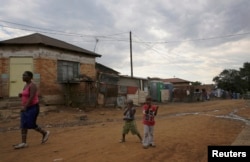Oupa Moloto says he will never forget the morning of June 16, 1976. Students at his school in the then-segregated Johannesburg township of Soweto had planned to protest against the government's insistence on teaching in the Afrikaans language.
He got to school just before 7 a.m. and joined the march to Soweto's Orlando Stadium. At first, he said, the mood was upbeat.
"When the shooting started, I was not sure it was a gun," said Moloto, who now works with a foundation dedicated to the Soweto student uprising. "It sounded like a cracker. Until I saw a boy was next to me bleeding from the hand."
Estimates vary on how many children were killed by police in those protests. Some go as high as 700. One of the first victims was 13-year-old Hector Pieterson, whose name today adorns a museum on the site of the massacre.
As President Jacob Zuma remarked at Thursday's 40th anniversary celebrations, South Africa will never forget.
The students' protest illuminated the unfairness of the racist apartheid regime. And the famous photo of Pieterson's prone, bleeding body helped mobilize the world against apartheid.
"Students revolted not only against the imposition of Afrikaans but against Bantu education because they knew it was inferior and that it was designed to prepare them to be drawers of water and hewers of wood," Zuma said in his speech Thursday. "The apartheid ideology espoused that whites were by nature superior and that blacks were inherently inferior."
South Africa has a long way to go, Zuma acknowledged, a fact illuminated by university students when they launched protests last year demanding free education.
Moloto and other struggle veterans agreed that apartheid-era divisions remain. For example, black students remain significantly poorer than their white peers. But none of them said they regretted their activism.
"My kids got education from multiracial schools," said Moloto, who is now 58. "To them, issues of color, issues of race, they are not entrenched like when I was growing [up]. Because when I was growing [up], issues of race were the key, they were determining."
Florence Kganye was also an 18-year-old high school student in 1976, and participated in student protests in the city of Bloemfontein.
"It was worth it," she said this week attempting to shepherd 200 excited, blue-uniformed students on a field trip to the Hector Pieterson museum. "Because what we fought for, what the other students that died fought for, at least we do have the freedom now that we were fighting for."
She says the police gave her a lasting reminder of her activism.
"Even now, I have a pain at my back," she said. "... It's from the beating. Because in those rooms where they locked us... they were beating us with something like a plank."
If anything, she says, the experience galvanized her. Today, she is the principal of a Catholic school in Johannesburg. She emphasized education with her own two children, she said, beaming as she told of her oldest, who is now a university student.
Today's youth say they have not forgotten their elders' sacrifices.
"Let us thank them for what they did for others, because we have freedom," said 15-year-old Wladeck Ndlovu. "We can do everything in this country."
He smiled shyly as he said he wants to become a lawyer when he grows up. For Moloto, and Kganye -- and even Zuma -- that was an impossible ambition in a nation where black students could not go to top universities, could not live where they pleased, could not look forward to voting or one day, becoming president.
But 40 years later, for Ndlovu and his friends, nothing seems impossible.







